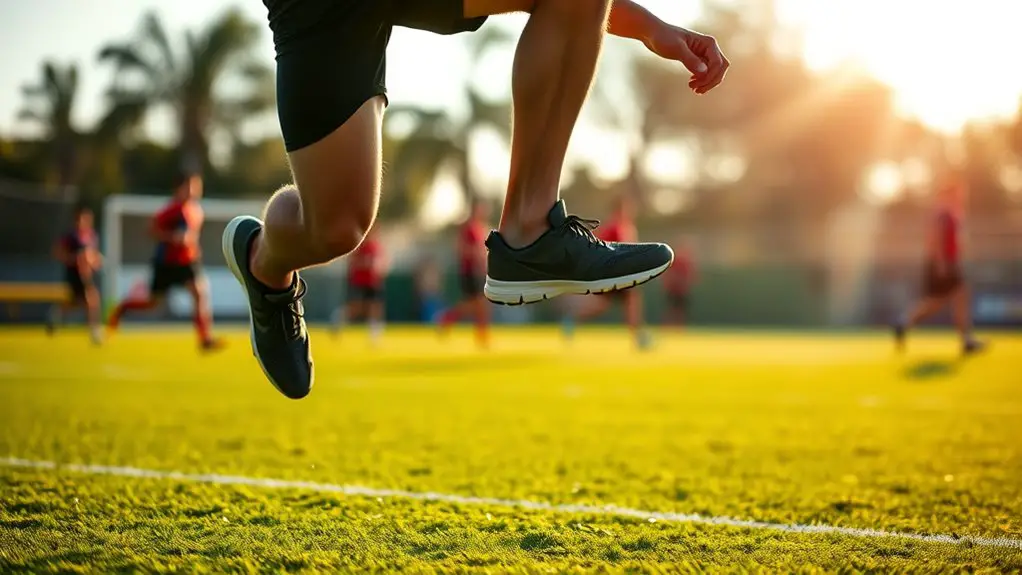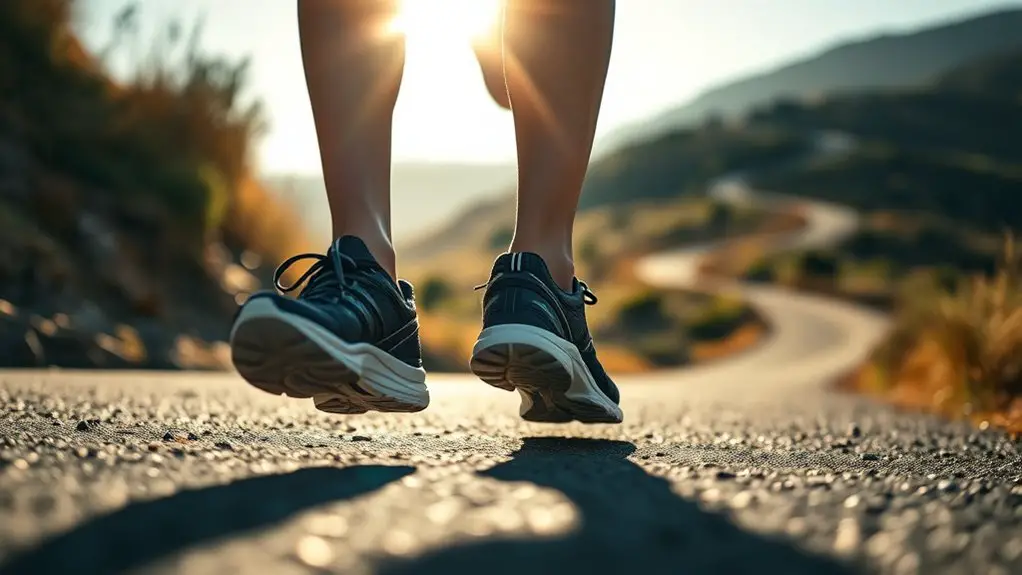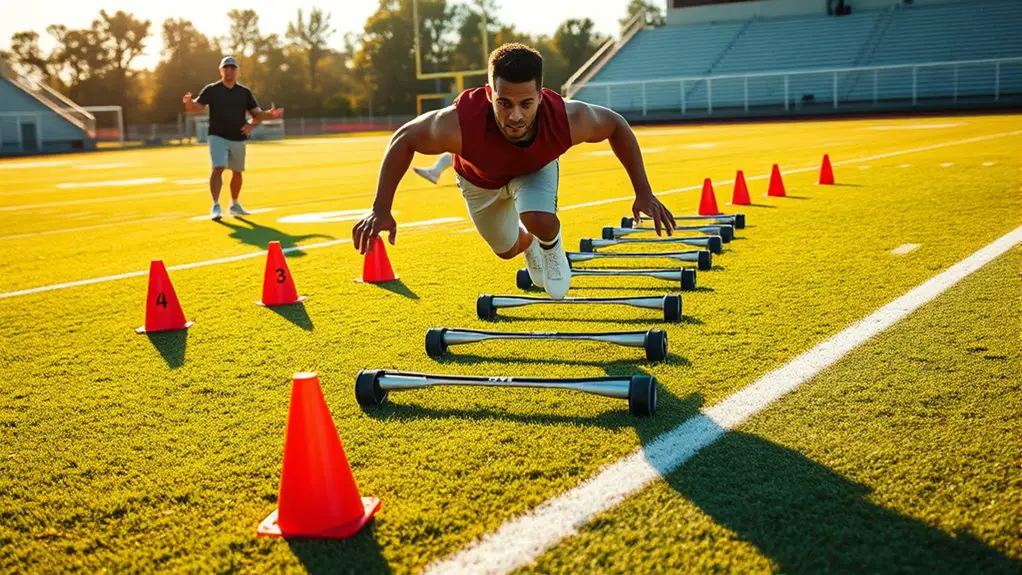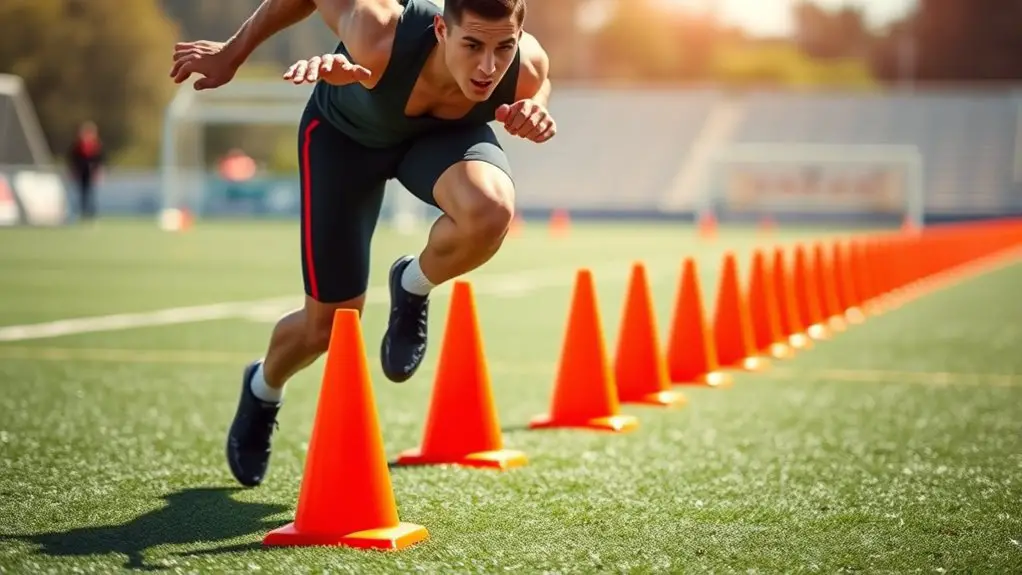The best single-leg exercises for sport performance include single-leg squats, single-leg deadlifts, Bulgarian split squats, and single-leg calf raises. These movements enhance strength, balance, and stability—key components for athletic success. Single-leg hops can also boost your agility and coordination. By focusing on one leg at a time, you'll improve muscle endurance and reduce injury risks. Keep exploring, and you'll discover how these exercises can take your performance to the next level.
Benefits of Single-Leg Exercises for Athletes
When you incorporate single-leg exercises into your training routine, you're not just enhancing your strength; you're also improving your balance and stability. This can reveal a whole new level of performance, allowing you to move freely and confidently in your sport. By focusing on one leg at a time, you engage your core and stabilizing muscles, which is essential for functional movement. This increased engagement translates directly to better control during athletic activities.
Moreover, single-leg exercises are fantastic for injury prevention. They help identify and correct muscular imbalances, reducing the risk of strains and sprains. You'll find that as you build strength in each leg independently, your overall athleticism improves, giving you that sense of freedom to perform at your best. Additionally, strengthening exercises for hamstring resilience can further support your performance and reduce injury risk. Take the leap and embrace single-leg training; your body will thank you, and your game will elevate to new heights.
Single-Leg Squats: Building Strength and Balance
Single-leg squats are an excellent way to build strength and balance, as they challenge your muscles and stability in a unique way. By incorporating single leg variations into your routine, you can enhance your overall athletic performance and promote better coordination. Unilateral training targets each leg individually, helping to identify and correct muscle imbalances while improving functional strength.
To perform a single-leg squat, stand on one leg, lower your body while keeping the other leg extended in front, and push back up. Start with shallow squats and gradually increase the depth as you gain confidence. Remember, form is key—focus on keeping your knee aligned over your ankle to prevent injury. Additionally, developing core strength reduces injury risk, allowing for more effective execution of these challenging movements.
Integrating these squats into your workouts not only builds strength but also boosts your balance, giving you the freedom to move more efficiently in your sport. So, challenge yourself and experience the benefits firsthand!
Single-Leg Deadlifts: Enhancing Stability and Power
While many exercises focus on bilateral movements, incorporating single-leg deadlifts can greatly enhance your stability and power. This exercise is perfect for anyone looking to break free from traditional training and explore single leg variations that boost performance. By engaging one leg at a time, you're not only developing strength but also improving balance and coordination.
Unilateral training like this helps address muscle imbalances, allowing you to build a solid foundation for athletic movements. As you lower your torso while keeping your back straight, you'll feel your core activate and your glutes engage, which is essential for explosive power. Additionally, focusing on proper warm-up routines can further enhance your performance and reduce the risk of injuries.
To get the most out of single-leg deadlifts, start with bodyweight or light weights, focusing on form. Gradually increase the load as you gain confidence and stability. Embracing this dynamic movement can reveal new levels of athletic potential, setting you on a path to greater freedom in your performance.
Bulgarian Split Squats: Targeting the Lower Body
Although many exercises emphasize bilateral training, Bulgarian split squats offer an excellent way to specifically target the lower body. This exercise not only improves strength but also enhances balance and stability, which are essential for athletic performance. By utilizing the Bulgarian technique, you can engage your quads, hamstrings, and glutes effectively. Additionally, engaging in exercises like the Bulgarian split squat promotes core stability, which is crucial for maintaining control and balance during athletic movements.
Here's a quick look at some exercise variations you can try:
| Variation | Target Muscles | Equipment Needed |
|---|---|---|
| Traditional Bulgarian | Quads, Glutes | Dumbbells |
| Elevated Front Foot | Hamstrings, Glutes | Bench or Box |
| Weighted Split Squat | Full Lower Body | Barbell/Dumbbells |
| Jumping Bulgarian Split | Power, Agility | Bodyweight |
| Pause Bulgarian Split | Control, Stability | Dumbbells |
Incorporating these variations keeps your workouts fresh and helps you access your lower body potential. Embrace the freedom to explore!
Single-Leg Calf Raises: Improving Ankle Strength
Single-leg calf raises are a fantastic way to boost your ankle strength, which is essential for overall athletic performance. By focusing on proper technique, you can maximize the benefits and reduce the risk of injury. Let's explore how to execute this exercise effectively and incorporate it into your training routine. Additionally, healthy joints play a crucial role in enhancing mobility and reducing the risk of injuries during athletic activities.
Benefits of Ankle Strength
Ankle strength is vital for athletes looking to enhance their performance across various sports. Strong ankles improve your ankle mobility, allowing for better balance and agility on the field or court. When you incorporate exercises like single-leg calf raises, you not only build strength but also enhance stability. This stability is essential, as it helps you navigate sudden movements and changes in direction, reducing the risk of injury. A robust ankle also supports proper biomechanics, which can elevate your overall athletic performance. By focusing on ankle strength, you're investing in injury prevention, giving you the freedom to push your limits and excel in your sport without the worry of setbacks. Embrace the power of strong ankles and release your potential!
Technique for Execution
To effectively improve your ankle strength through single-leg calf raises, focus on proper technique from the outset. Mastering single leg mechanics is essential for maximizing your gains. Here are some execution tips to keep in mind:
- Start on a stable surface; balance is key.
- Keep your core engaged to maintain stability.
- Allow your heel to drop below the step for a full range of motion.
- Push through the ball of your foot as you rise, focusing on controlled movement.
- Lower your heel slowly to emphasize the eccentric phase.
Incorporating Into Routine
Mastering the technique for single-leg calf raises sets the stage for effectively incorporating them into your training routine. To truly enhance your ankle strength, aim for a balanced exercise frequency. Start by including single-leg calf raises two to three times a week, adjusting as your strength improves. This allows your body to adapt while preventing overuse injuries.
To keep things fresh, mix in workout variety by pairing calf raises with other single-leg exercises like lunges or step-ups. You'll not only target different muscle groups but also keep your routine engaging. Remember, it's all about finding what works for you and aligns with your fitness goals. Embrace this freedom, and watch your performance soar!
Single-Leg Hops: Boosting Agility and Coordination
Single-leg hops are a fantastic way to enhance your balance and stability while also improving lateral movement. As you work on these hops, you'll strengthen your lower body muscles, which is essential for overall athletic performance. Additionally, incorporating strength training into your routine can significantly improve muscle power for directional changes, making your single-leg hops even more effective. Let's explore how this simple exercise can make a big difference in your agility and coordination.
Enhancing Balance and Stability
When it comes to enhancing balance and stability, single-leg hops are a game changer. These dynamic movements not only challenge your stability but also improve your overall athletic performance. By incorporating single-leg hops into your training, you'll reap the benefits of effective balance drills and rigorous stability training.
- Strengthen your core and lower body
- Improve proprioception and body awareness
- Develop coordination for better movement patterns
- Increase agility for quick directional changes
- Enhance overall athletic performance
Embracing single-leg hops will free you from the constraints of traditional training, allowing you to move more fluidly and confidently in your sport. So, get hopping and watch your balance and stability soar!
Improving Lateral Movement
To improve your lateral movement, integrating single-leg hops into your training routine can be incredibly effective. These hops not only enhance your lateral agility but also help you master essential movement patterns. By focusing on one leg at a time, you'll develop better coordination and balance, essential for any sport or physical activity. Start by hopping side to side, aiming for controlled landings. As you progress, challenge yourself with variations like adding a twist or increasing speed. This approach allows you to tap into your body's natural mechanics, freeing your movements and boosting performance. So, embrace single-leg hops and watch your agility and coordination soar—giving you the edge you need on the field or court.
Strengthening Lower Body Muscles
While incorporating single-leg hops into your training, you're not just enhancing your agility and coordination; you're also effectively strengthening your lower body muscles. These hops are a powerful way to boost muscle endurance, allowing you to perform better in your sport.
Benefits of single-leg hops include:
- Increased strength in your quads and hamstrings
- Enhanced balance and stability
- Improved joint integrity
- Greater explosiveness in your movements
- Boosted overall athletic performance
Frequently Asked Questions
How Often Should I Incorporate Single-Leg Exercises Into My Routine?
You should aim to incorporate single-leg exercises into your training schedule about two to three times a week. This frequency allows for ideal strength and balance gains without overloading your body. Listen to your body and adjust based on how you feel; freedom in your routine is key. Mixing in these exercises regularly can enhance your overall fitness, so don't hesitate to make them a staple in your workouts!
Can Single-Leg Exercises Prevent Injuries in Athletes?
Yes, single-leg exercises can definitely help with injury prevention. By strengthening stabilizing muscles and improving balance, you're reducing your risk of injuries, especially in high-impact sports. When you incorporate these exercises into your routine, you're not just enhancing your athletic performance but also building a solid foundation that supports your body during various movements. So, embrace the freedom that comes with being stronger and more resilient on one leg!
What Equipment Do I Need for Single-Leg Exercises?
Think of your body as a finely-tuned instrument, ready to harmonize with single-leg exercises. To immerse yourself in balance training and build unilateral strength, you don't need a lot—just a few essentials. A sturdy bench or step, dumbbells or kettlebells for added resistance, and a stability ball can work wonders. With these tools, you'll unlock your potential and embrace the freedom to move confidently and efficiently in any sport or activity you love.
Are Single-Leg Exercises Suitable for Beginners?
Absolutely, single-leg exercises are suitable for beginners! They offer great benefits, like improving balance and stability. You can start with beginner modifications, such as using a wall for support or performing the exercises with a lighter weight. This way, you can focus on your form while still enjoying the freedom to challenge yourself. As you gain confidence, you can gradually increase the difficulty, revealing even more benefits along the way.
How Do I Progress Single-Leg Exercises Over Time?
Think of your fitness journey like climbing a mountain—each step up is a new challenge. To progress in single-leg exercises, embrace progressive overload. Start with basic variations, then gradually increase difficulty by adding weight or trying more complex movements. It's like leveling up in a game; each new exercise variation keeps things fresh and exciting. Remember, you've got the freedom to explore different paths and discover what works best for you!




